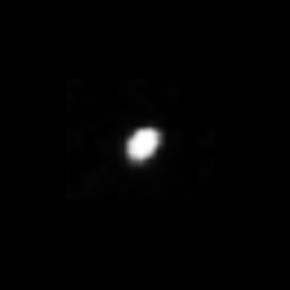- There is also an asteroid called 1285 Julietta.
 | |
| Discovery | |
|---|---|
| Discovered by | Stephen P. Synnott / Voyager 2 |
| Discovery date | January 3, 1986 |
| Designations | |
| Designation | Uranus XI |
| Pronunciation | /ˈdʒuːliɛt/ |
| Adjectives | Julietian |
| Orbital characteristics | |
| Semi-major axis | 64,358.222 ± 0.048 km |
| Eccentricity | 0.00066 ± 0.000087 |
| Orbital period (sidereal) | 0.493065490 ± 0.000000012 d |
| Inclination | 0.06546 ± 0.040° (to Uranus' equator) |
| Satellite of | Uranus |
| Physical characteristics | |
| Dimensions | 150 × 74 × 74 km |
| Surface area | ~30,000 km |
| Volume | 430100±23.0% km |
| Mass | (3.871±0.891)×10 kg |
| Mean density | ≥0.61 g/cm ~0.90 g/cm (assumed) |
| Surface gravity | ~0.005–0.019 m/s |
| Escape velocity | ~0.026–0.037 km/s |
| Synodic rotation period | synchronous |
| Axial tilt | zero |
| Albedo | 0.08 ± 0.01 |
| Temperature | ~64 K |
| |
Juliet is an inner satellite of Uranus. It was discovered from the images taken by Voyager 2 on 3 January 1986, and was given the temporary designation S/1986 U 2. It is named after the heroine of William Shakespeare's play Romeo and Juliet. It is also designated Uranus XI.
Juliet belongs to the Portia group of satellites, which also includes Bianca, Cressida, Desdemona, Portia, Rosalind, Cupid, Belinda, and Perdita. These satellites have similar orbits and photometric properties. Other than its orbit, size of 150 × 74 km, and geometric albedo of 0.08, virtually nothing is known about Juliet.
In Voyager 2 imagery, Juliet appears as an elongated object, with its major axis pointing towards Uranus. The ratio of axes of Juliet's prolate spheroid is 0.5 ± 0.3, which is a rather extreme value. Its surface is grey in color.
Juliet may collide with Desdemona within the next 100 million years.
See also
Notes
References
- Benjamin Smith (1903). The Century Dictionary and Cyclopedia.
- W. M. Anderson (1892). "Daniel Johnson Brimm". Shield and Diamond. Vol. 2, no. 1. p. 116.
- John Robert Reed (1985) Decadent style, p.38.
- ^ Jacobson, R. A. (1998). "The Orbits of the Inner Uranian Satellites From Hubble Space Telescope and Voyager 2 Observations". The Astronomical Journal. 115 (3): 1195–1199. Bibcode:1998AJ....115.1195J. doi:10.1086/300263.
- ^ Karkoschka, Erich (2001). "Voyager's Eleventh Discovery of a Satellite of Uranus and Photometry and the First Size Measurements of Nine Satellites". Icarus. 151 (1): 69–77. Bibcode:2001Icar..151...69K. doi:10.1006/icar.2001.6597.
- ^ French, Richard G.; Hedman, Matthew M.; Nicholson, Philip D.; Longaretti, Pierre-Yves; McGhee-French, Colleen A. (2024-03-15). "The Uranus system from occultation observations (1977–2006): Rings, pole direction, gravity field, and masses of Cressida, Cordelia, and Ophelia". Icarus. 411: 115957. arXiv:2401.04634. Bibcode:2024Icar..41115957F. doi:10.1016/j.icarus.2024.115957. ISSN 0019-1035.
- ^ Karkoschka, Erich (2001). "Comprehensive Photometry of the Rings and 16 Satellites of Uranus with the Hubble Space Telescope". Icarus. 151 (1): 51–68. Bibcode:2001Icar..151...51K. doi:10.1006/icar.2001.6596.
- Smith, B. A. (January 16, 1986). "Satellites of Uranus". IAU Circular. 4164. Retrieved 29 October 2011.
- "Planet and Satellite Names and Discoverers". Gazetteer of Planetary Nomenclature. USGS Astrogeology. July 21, 2006. Retrieved 6 August 2006.
- Duncan, Martin J.; Lissauer, Jack J. (1997). "Orbital Stability of the Uranian Satellite System". Icarus. 125 (1): 1–12. Bibcode:1997Icar..125....1D. doi:10.1006/icar.1996.5568.
External links
- Juliet Profile by NASA's Solar System Exploration
- Juliet + Ring diagram (Courtesy of Astronomy Magazine 2005)
- Uranus' Known Satellites (by Scott S. Sheppard)
| Uranus | |||||||
|---|---|---|---|---|---|---|---|
| Geography | |||||||
| Major moons | |||||||
| Astronomy |
| ||||||
| Exploration |
| ||||||
| Related | |||||||
| Moons of Uranus | |||||
|---|---|---|---|---|---|
| |||||
| Inner | |||||
| Major (spheroid) | |||||
| Outer (irregular) |
| ||||
| Geological features | |||||
| Natural satellites of the Solar System | ||
|---|---|---|
| Planetary satellites of |   | |
| Dwarf planet satellites of | ||
| Minor-planet moons | ||
| Ranked by size | ||